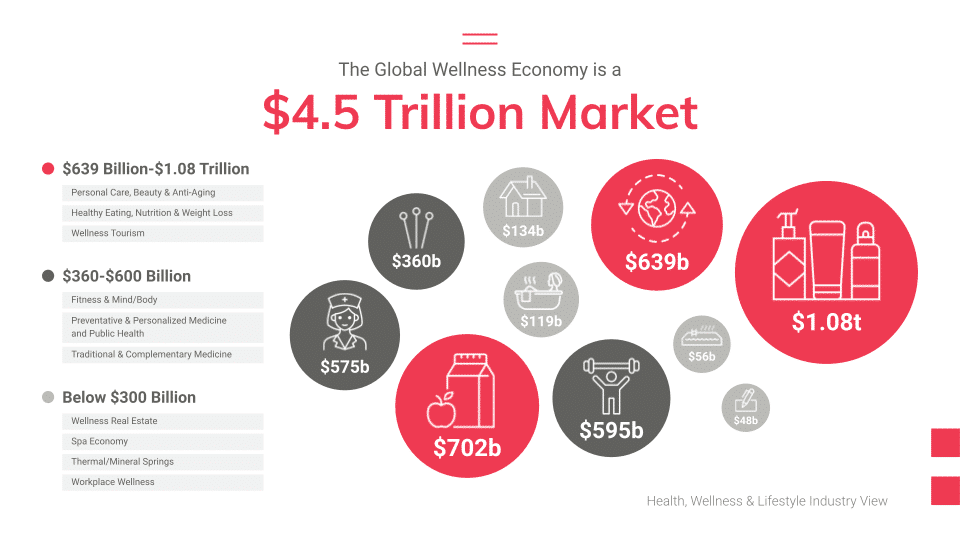Three fundamentals of health & wellness brand strategy to drive awareness, growth, impact, and consumer trust.
Introduction
The global wellness industry is expanding at breakneck speed, growing by 6.4% annually over a two-year period. That’s nearly twice as fast as overall global economic growth. By 2026, the industry is predicted to hit $6.54 billion and have a compound annual growth rate of 4.8% from 2019.

Yet, industry growth is no guarantee of individual success. Today’s health and wellness brands face tougher competition than ever, and a brand’s ability to win fierce competition across the digital and physical landscape will ensure its longevity, growth, and ability to help customers live healthy lives. In the U.S. alone, there are over 760,000 health and wellness brands, but most appear very similar to consumers and get lost in a sea of health-focused marketing. The few that truly stand out have mastered three fundamentals of brand strategy.
Three foundations for success in the global health and wellness industry
While the landscape of health and wellness brands has rapidly evolved, the core mission remains the same: to do good things and to build successful businesses along the way. But how? Focus on three brand fundamentals for growth and impact that remain true amidst all the other changes in the wellness industry.
I. Be a trusted authority figure
This first point is generally easier said than done and extends beyond amassing a library of digital content or booking a few guest radio appearances. To compete in today’s global health and wellness industry, you will have to become an expert and a credible source for potential consumers, as well as for your peers and competition. You need to ask how you can be the absolute go-to source for your area of expertise.
-
- Demonstrate knowledge. Start with the fundamentals — by sharing your native expertise through publishing books, podcasts, industry research, and scientific studies. Strive to be the go-to authority about your area of expertise so you’re able to drive the dialogue in your space. Gwyneth Paltrow’s goop not only sells products, but also is an active publisher and podcaster on a wide variety of health and wellness topics. As they say, “We take a curious, open-minded, and service-centric approach to the work we do. We ask questions about all of it. We believe that people can take what serves them and leave what doesn’t. We recommend what we love and what we think is worthy of your time and wallet. We value your trust above all things.”
- Affiliate with other credible sources. Think of the power Oprah Winfrey has over people’s book purchasing choices. In 1996, she began to curate books for her followers to read. Each time she announced her latest pick, that book would predictably fly off the shelves and climb up the charts. Some libraries, such as the New York Public Library, have opted to work alongside Oprah’s Book Club, crafting displays and special events around Oprah’s picks. This affiliation with Oprah helps them maintain their position of authority across the literary industry. For your organization, this might take the form of co-authoring a book or white paper, co-producing an industry event or forming strategic alliances with organizations or other health and wellness brands who have already garnered consumer trust through their own efforts.
- Teach people something. Teaching others is one of the quickest ways to establish domain authority. Hemp producer Charlotte’s Web prioritizes hemp education across its platforms, and in doing so, establishes their authority as a leader and expert in this burgeoning field.
Through demonstrating knowledge, teaching, and linking arms with other like-minded experts in the industry, you’re already well on your way to becoming a trusted authority figure to help cement your organization’s growth and success.
II. Be (Really) Authentic
- Be willing to go all in. Authenticity as a concept or catchphrase has been trendy with brands and marketers for some time now. In an age when consumers are often privy to a “chef’s table” view of the inner workings of a company (like its manufacturing floor or compensation structure), authenticity is a crucial element to ensuring your organization’s growth. But to be truly authentic, you need to be comfortable sharing who you are, not just your impression of what authentic should look like. Attempting to “manufacture authenticity” just for show puts brands at risk for losing consumer trust if these values aren’t demonstrated throughout the company. Ask yourself whether you’re open about your ambitions and transparent about your actions. Are your company policies, strategies, partners, vendors, and/or supply chains all reflective of your true values?
- Live your values when it matters most. In the early days of a global pandemic and ensuing economic challenges, Tim Boyle, President and CEO of Columbia Sportswear Company, announced in 2020 that the company’s employees would receive their regular pay as he reduced his own salary to $10,000. “Our employees will continue to be paid during this period, and we hope to have them back at work soon,” Boyle said in his recent announcement. In doing so, he’s demonstrating that the company’s social responsibility initiatives are more than just website copy. According to Columbia’s website, one of their core values is “doing the right thing for consumers, customers, employees, the company & our communities.” Guaranteeing full pay to employees unable to work, especially in such a peak moment of crisis, was a way to ensure Columbia Sportswear employees truly felt the impact of their company authentically living its values.
III. Create a movement
The final fundamental for growth and impact lies in your ability to aggregate others and create a micromovement that generates momentum for your brand, resonates with consumers, and can help move the needle on vital social issues.
- Change the conversation. For Mamava, a business that sells lactation rooms (or “nursing pods”) for offices and public spaces, movement-building is baked into the company’s mission. The brand states boldly on its website that it is “dedicated to transforming the culture of breastfeeding.” Mamava doesn’t “only” produce freestanding pods that allow women in offices, airports, stadiums, and schools around the world to pump or breastfeed privately — it has helped change societal attitudes and pursuant policies around the act of pumping or breastfeeding. Mamava uses movement-building language across its brand and fabricates pods to be purposefully conspicuous: they’re bold, they’re bright, and they’re conversation-starters by design. You don’t need a call to action to start a movement. Movement research shows that movements actually start with discontent with the status quo that coalesces into a movement by a new, positive vision. For Mamava, the movement-building catalyst was the fact that nursing and pumping mothers were tired of not having a private, clean place to feed their infants. Mamava promised — and regularly proves — it could make things better for them.
- Build an empowered community. A brand that doesn’t necessarily have movement-building baked into its original mission but has managed to start a movement regardless is the fitness brand Orange Theory. With more than 1 million members, over 1,300 studios in all 50 US states and over 23 other countries, the company has already seen extraordinary growth for a fitness franchise brand. It’s not stopping there; Orange Theory also reached $1 billion in sales in a single year and plans to reach 2,500 locations globally by 2025. What makes this fitness brand stand out and keep growing at such an impressive rate?
Part of the “secret sauce” might be in the brand’s ability to create a community across studios and timezones: the uniform look and nature of the workout across each studio virtually connects members no matter where they’re working out. Each member is shooting toward the common goal of Orange Theory’s signature “splat zone,” which is the orange-hued indicator that they’re in their target heart rate zone. The company has also helped build community within and among studios through regular events and speaker series.
One could argue that Orange Theory’s biggest contribution to the fitness industry is the idea that each body is different, and each person has his or her own hurdles to clear: we are our own biggest and best competitor. “Splat Zones” are different for each person and other rapidly-growing fitness brands have adopted similar concepts, such as Peloton’s badge system, which is entirely based on a member’s own performance and progress. Orange Theory has helped build a movement around the shifting definition of competition across personal fitness.
Keep Growing and Evolving. Keep Doing Good Things.
The definition of brand success in the health and wellness industries remains the same, even through a rapidly evolving landscape: to do some good things and build successful brands. By becoming a trusted expert in your field, being truly authentic, and sparking a movement that catalyzes social change, you can do both.
